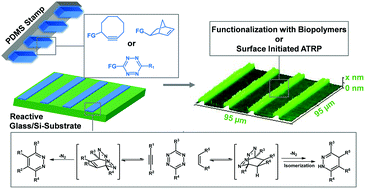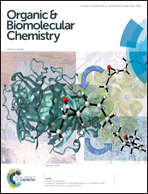Surface patterning with natural and synthetic polymers via an inverse electron demand Diels–Alder reaction employing microcontact chemistry†
Abstract
Bioorthogonal ligation methods are the focus of current research due to their versatile applications in biotechnology and materials science for post-functionalization and immobilization of biomolecules. Recently, inverse electron demand Diels–Alder (iEDDA) reactions employing 1,2,4,5-tetrazines as electron deficient dienes emerged as powerful tools in this field. We adapted iEDDA in microcontact chemistry (μCC) in order to create enhanced surface functions. μCC is a straightforward soft-lithography technique which enables fast and large area patterning with high pattern resolutions. In this work, tetrazine functionalized surfaces were reacted with carbohydrates conjugated with norbornene or cyclooctyne acting as strained electron rich dienophiles employing μCC. It was possible to create monofunctional as well as bifunctional substrates which were specifically addressable by proteins. Furthermore we structured glass supported alkene terminated self-assembled monolayers with a tetrazine conjugated atom transfer radical polymerization (ATRP) initiator enabling surface grafted polymerizations of poly(methylacrylate) brushes. The success of the surface initiated iEDDA via μCC as well as the functionalization with natural and synthetic polymers was verified via fluorescence and optical microscopy, X-ray photoelectron spectroscopy (XPS), time-of-flight secondary ion mass spectrometry (ToF-SIMS), atomic force microscopy (AFM) and attenuated total reflection Fourier transform infrared spectroscopy (ATR-FTIR).

- This article is part of the themed collection: Recognition and Reactivity at Interfaces

 Please wait while we load your content...
Please wait while we load your content...